Andesite is a fairly common rock type, and can be found in locations all around the world. Chances are good that you have seen and touched andesite many times in your life, whether or not you were aware of it at the time. It comes in many varieties, and it is worth learning more about due to its prevalence and geologic significance.
Andesite can sometimes be fairly difficult to identify, partly because it comes in so many varieties and partly because it is sometimes confused with other rock types. This is perfectly understandable because many igneous rocks can superficially look very similar and they share many of the same physical properties. It can be difficult to know exactly what andesite looks like and how to identify it, but it is relatively simple if you know what to look for.
Andesite is an extrusive igneous rock composed primarily of plagioclase feldspar and large amounts of mafic minerals like hornblende. It has an aphanitic texture, meaning its interlocking crystals cannot be seen by the naked eye. Andesite comes in many colors but is usually light or dark gray, and is often porphyritic.
Andesite is intermediate in composition between basalt and rhyolite. While andesite is a clearly defined rock type, it can sometimes be hard to distinguish it from closely related rocks – especially if you don’t have access to sophisticated testing methods. I’ll walk you through identifying andesite, what it looks like, and where it can be found.
What Does Andesite Look Like?
Most people have seen andesite many times in their life – often without realizing it. Andesite is intermediate in composition, containing less quartz than felsic rhyolite and more quartz than mafic basalt, but it can sometimes be difficult to distinguish when it comes to the percentage of mafic minerals present.
There are many different varieties of andesite, each with its own unique properties and appearance, but all varieties of andesite have quite a bit in common when it comes to their overall look. So, what does andesite look like?
Andesite has a fine-grained texture with very small, interlocking crystals of white to off-white plagioclase feldspar and darker, mafic minerals like hornblende. The crystals are too small to see with the naked eye. Andesite is usually light to dark gray and often contains larger crystals called phenocrysts.
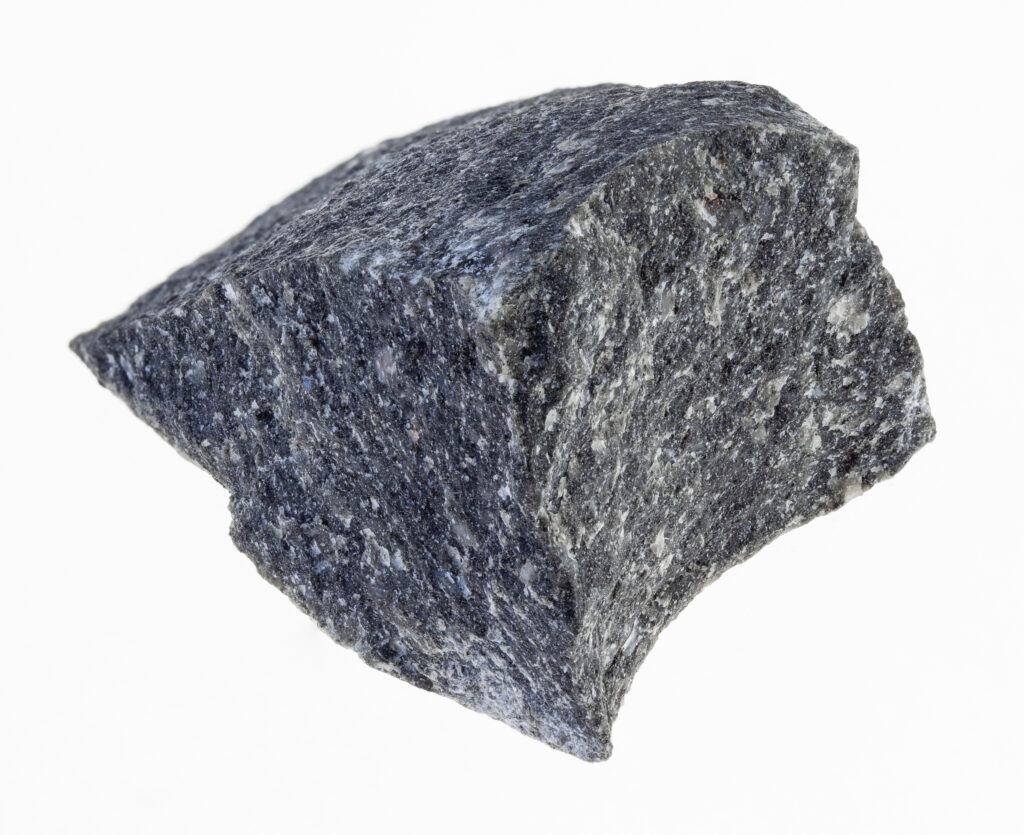
Most varieties of andesite are very hard and well-consolidated rocks. However, some rocks with andesitic mineralogy are made of volcanic ash, known as tuff. Some geologists prefer to classify these tuffs as a variety of andesite, but for our purposes, we will treat them as a separate rock type.
Large crystals are often present in the fine-grained groundmass of andesite. These are known as ‘phenocrysts‘ and are usually made of plagioclase feldspar, hornblende, or pyroxene. They occur when andesitic magma has time to crystallize minerals with higher melt points before being erupted to the surface.
One of the defining characteristics of andesite is its overall lack of quartz. Rocks like rhyolite and dacite have quite a bit of quartz (over 20%) but true andesite is almost completely devoid of any appreciable amount of quartz.
There are many variations of andesite that can look quite different from one another. These differences are due to subtle variations in mineralogy, the gas content of the lava, and how the lava cooled. Even small differences in these conditions can have a drastic impact on what andesite looks like.
Color is Driven by Mineralogy
The major minerals present in all andesite are pyroxene, hornblende, and plagioclase feldspar. Alkali feldspars are also sometimes present at up to 35% of the total feldspar content. Each of these minerals can present itself in different ways. The plagioclase feldspar is typically a species called andesine, while pyroxene minerals can include augite and orthopyroxene.
Quartz is almost entirely absent from andesite. In some andesites, however, it can be present at up to 20% of the total rock volume. Of course, it is usually impossible to estimate the percentage of quartz in an andesitic rock (if any is present at all) because the crystals are too small to see. In any case, quartz is not a significant contributor to andesite’s overall dark color because it simply isn’t prevalent enough.
Feldspar has much more variety than quartz. It is actually a group of minerals that can be divided into two main types: plagioclase feldspar and alkali feldspar. These two types of feldspar can look quite different from one another, and can even vary significantly in appearance themselves. Both are present in andesite.
Plagioclase feldspar is often the most abundant mineral in andesite, making up over 65% of the total feldspar content. There are several species of plagioclase feldspar but, in andesite, it is usually andesine.
The ratio of plagioclase to darker, mafic minerals is the primary determining factor of how dark a piece of andesite appears. As a general rule, andesite is fairly dark and will have a ‘color index’ below 40, indicating that fewer than 40% of the minerals present are dark, mafic minerals.
Some of the most common mafic minerals (making up to 15-40% of the total rock volume) in andesite are pyroxene and hornblende. Hornblende and pyroxene are very dark minerals and contribute significantly to andesite’s overall gray coloration. Olivine is also sometimes present in smaller quantities and, while considered a mafic (or ultramafic) mineral, it has a characteristic green color that sometimes gives andesite a greenish tinge.
The groundmass (the main, fine-grained part of the rock) of andesite is almost always light gray to dark gray. Contained within that groundmass you will very often see large, differently-colored crystals (phenocrysts). For example, plagioclase feldspar phenocrysts will look like white splotches or even very well-defined white crystals in a mass of fine-grained gray rock.
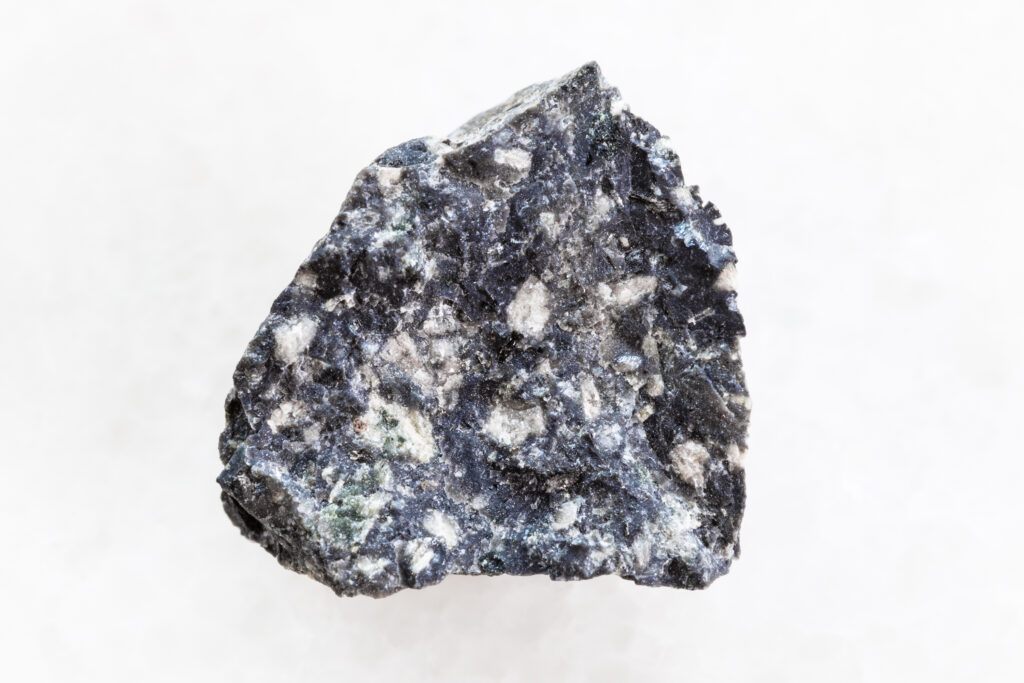
Texture of Andesite
One of the defining features of andesite’s appearance is its texture. All andesite is fine-grained, meaning that you cannot see the individual crystals in the rock. This texture is known as ‘aphanitic’ and it occurs when magma cools rapidly, preventing crystals from having enough time to grow before becoming completely solidified.
While all andesites are aphanitic, it is also possible (and even common) to describe their texture in other ways. Rocks can be described as having more than one texture as long as the texture types are not mutually exclusive.
As I mentioned above, andesite is very often ‘porphyritic’. This texture describes large, visible crystals surrounded by a fine-grained groundmass. It occurs when minerals with a higher melt point have time to crystallize in the magma melt before the magma erupts to the surface and the entire melt rapidly crystallizes around them.
Andesite that is not porphyritic may often be described as ‘equigranular‘, which means that all of the crystals are approximately the same size. So, an andesitic rock may be described as ‘aphanitic and equigranular’ if it is made up of minute crystals with no visible phenocrysts.
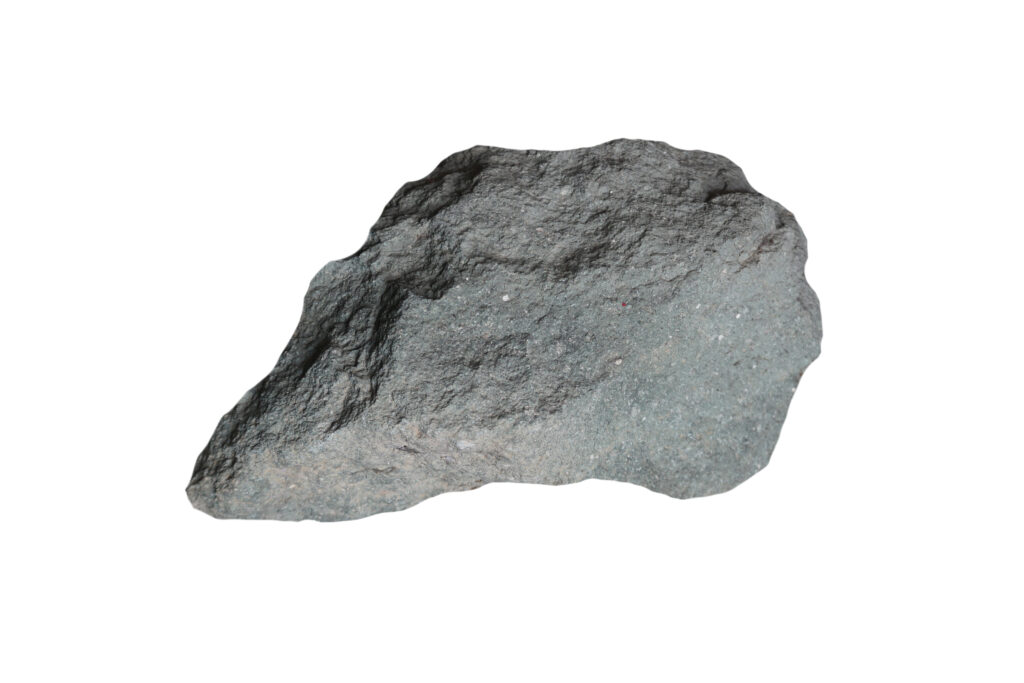
How to Identify Andesite
As common as andesite is, it can still sometimes be difficult to identify. I think this is because it tends to be a fairly bland and uninteresting rock – at least at first glance. There are sometimes very few defining features on which to base an identification. As with any rock, it is important to take a systematic approach when identifying andesite.
To identify andesite, you should first ensure that you cannot see the crystals in the groundmass with the naked eye. Dark, mafic minerals should make up 15-40% of the rock by volume. Some larger, visible crystals may be present. Andesite is usually light or dark gray, but can also be brown, green, or reddish.
A rock must meet all of these requirements to be considered andesite:
- Igneous – Formed from cooling magma, with interlocking crystal grains.
- Fine-grained – Aphanitic texture with groundmass crystals not visible to the naked eye
- Intermediate Mineralogy – 15% to 40% of the rock is dark, mafic minerals. The rest is mostly plagioclase feldspar with very little quartz
If your rock meets all of those criteria then it is very likely andesite, or at least something very closely related. Remember that andesite comes in many different morphologies and that one specimen can look very different from the next.
Tip: This article is part of my igneous rock identification series. To read more about how to identify all igneous rocks, check out my article here.
It can sometimes be very difficult to distinguish andesite from closely related rock types like basalt. The best you can do is to first estimate the percentage of dark, mafic minerals in the rock. If it is under 40% and over 10% then your rock is intermediate, which helps you rule out basalt and rhyolite as possibilities. The presence of plagioclase phenocrysts is also a great indication that your rock is andesite.
When observing and identifying a rock like andesite it can often be useful to use a hand lens like this one from Amazon. This allows you to see the individual crystal grains more clearly and often helps you identify the specific species of minerals present in a rock.
Like most rocks, andesite can become very weathered when exposed to the elements. This can make it hard to identify because the colors can change significantly and many of the features become more difficult to see. When making any rock identification it is usually best to break off a piece of the rock (if you’re able) and look at a fresh surface.
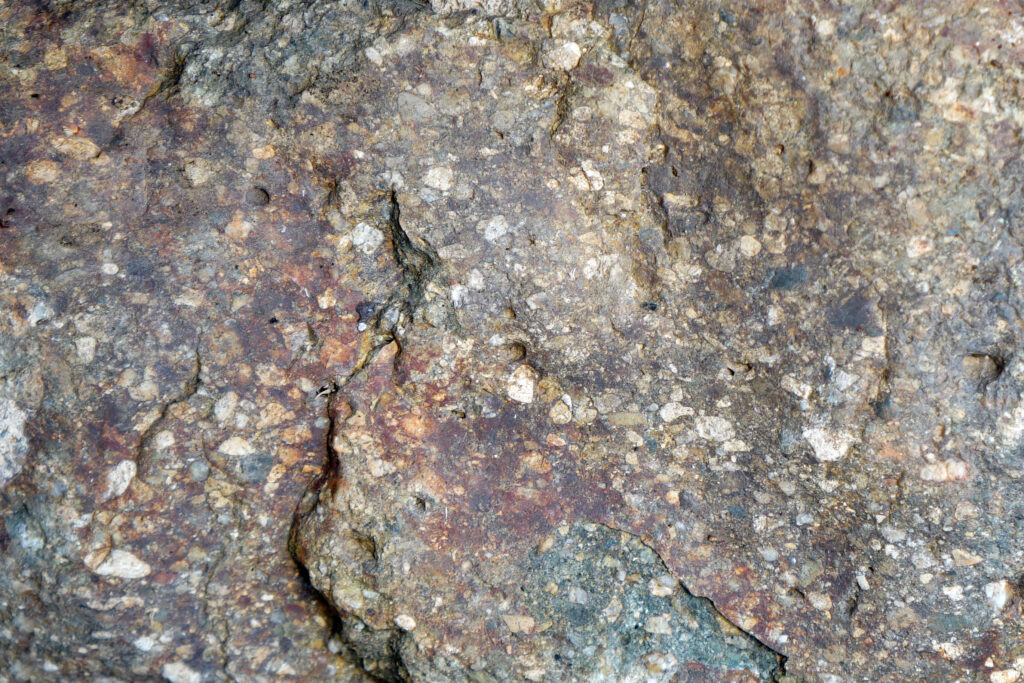
What Is Andesite Made Of?
As I mentioned above, andesite is largely defined by a specific mineralogy. All rocks are made from one or more minerals, and in order to fully understand a rock like andeiste you have to know what those minerals are.
The mineral composition of andesite consists of minute crystals of 10-40% mafic minerals like pyroxene and hornblende, with the rest of the rock containing 0-20% quartz and 65-100% of the total feldspar being plagioclase. Other accessory minerals like olivine may also be present in small quantities.
This definition is very specific, but without sophisticated methods for measuring mineral types and percentages it is impractical (or even impossible) for us to determine if an andesite-like rock falls into those specific percentage ranges. For casual purposes, assigning an identification by visually estimating the percentages of minerals based on overall color is almost always sufficient.
It is useful to know what some closely-related rock types are called and what their mineralogy looks like.
- Basalt – Quartz-deficient, with more plagioclase than alkali feldspar and more darker (more mafic minerals) than andesite
- Dacite – Quartz-rich, with more plagioclase than alkali feldspar
- Trachyte – Quartz-deficient, with more alkali feldspar than plagioclase
- Rhyolite – Quartz-rich, with more alkali feldspar than plagioclase
- Diorite – Mineralogical equivalent of andesite, but coarse-grained
Where Is Andesite Found?
Andesite is a fairly common igneous rock that can be found in locations spread all around the world. However, it isn’t as widespread as rocks like basalt and is typically constrained to specific geologic settings.
In general, andesite is found on the continental side of subduction zones where partial melting of basaltic crust results in stratovolcanoes forming over large areas. It is also sometimes associated with hot spots and any other geologic environments where basaltic magma mixes with granitic magma.
Andesite is intermediate in composition, meaning it is somewhere between basaltic and granitic magma. This intermediate mixture usually occurs when the two different magma types are mixed together.
By far the most common geologic environment in which this occurs is convergent plate boundaries with subduction zones. I’ll explain more in detail why this is the case in the next section of this article.
Andesite is composed of relatively hard minerals (primarily feldspar and pyroxene) which make it incredibly durable. Once it is exposed to the surface it takes a long time for it to break down. Pieces of andesite can survive in a river for great distances, which is why you can sometimes find pieces downriver from its source.
You can look for andesite formations near you using this excellent interactive map from the USGS. I have a video about how to use this tool in my Practical Rock Identification System, plus even more information on how to identify andesite and other rocks.
In the U.S., andesite is most commonly found in the western states – particularly in the Pacific Northwest in association with large stratovolcanoes such as Mount Rainier and Mt. Saint Helens.
How Does Andesite Form?
We’ve learned all about what andesite looks like, what it is composed of, and generally where it’s found, but I have only briefly touched on how it’s actually formed. The creation of andesite is a relatively straightforward process that always follows a few simple rules but can vary significantly in the details.
Andesite forms when magma, intermediate in composition between basalt and granite, rapidly cools at or near the Earth’s surface, negating the opportunity for the formation of large crystals. This most commonly occurs in volcanic arcs associated with subduction zones but also occurs in hot spots and other settings.
The creation of andesite really begins with oceanic plates, which are basaltic in composition. At subduction zones, oceanic plates sink below continental plates which are generally made of more granitic rock. Once the oceanic plate reaches a certain depth and temperature it begins to melt, forming basaltic magma.
This partial melting causes the basaltic magma to work its way up through the granitic continental crust where it melts and mixes with sediments and granitic rock, fundamentally changing the chemistry of the magma. It continues to the surface where it eventually erupts, forming andesite.
The phenocrysts that are so commonly seen in andesite form before an eruption. As the intermediate magma mixture sits below the surface, it sometimes has enough time for larger crystals of plagioclase feldspar and other minerals to form. Then, when the magma erupts to the surface, the rest of the mixture rapidly cools into smaller crystals surrounding the larger ones.
Andesitic lava flows slowly when compared to basaltic lava because it has a higher viscosity. It tends to erupt more violently and form steeper volcanos with large blocks of rock. As the lava comes into contact with the air it cools very quickly, which doesn’t allow very much time for the nucleation and growth of large crystals.
Because the composition of the source magma is never exactly the same from one andesite to another and the surrounding environment is always different, there can be quite a lot of variation in how the lava cools and the crystals form. This is how you get different morphologies when the andesite finally cools into its solid form.
As the individual crystals of andesite’s various minerals cool down, they eventually run into each other and run out of room. Crystallization will continue until all of the magma is solidified, leaving behind interlocking crystals with virtually no porosity between them.
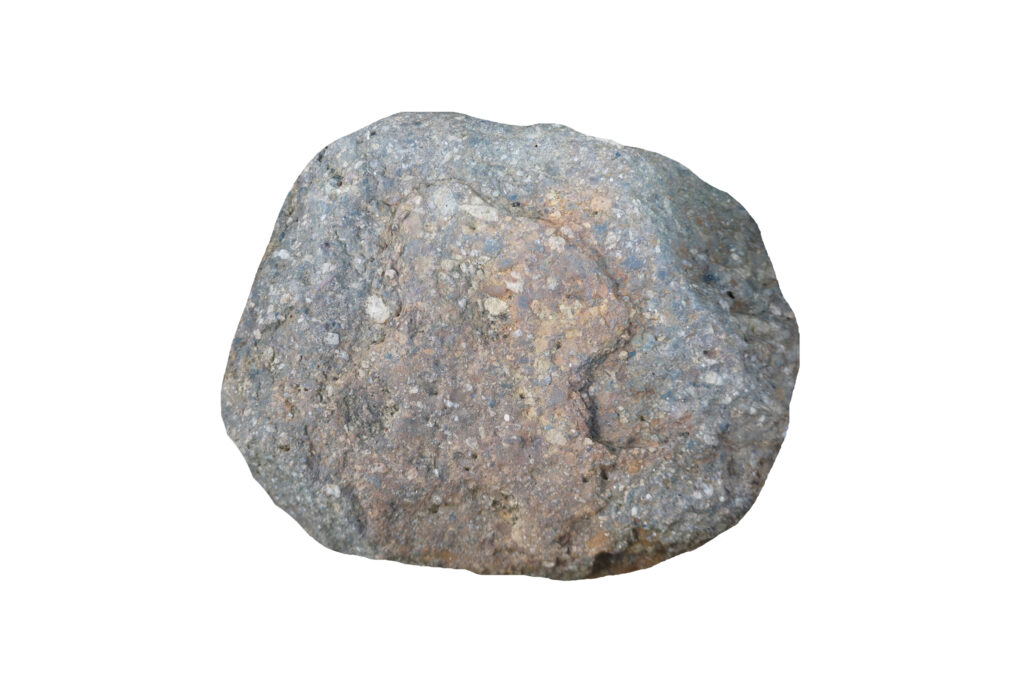
What Is Andesite Used For?
Chances are good that you have seen plenty of andesite in your day-to-day life, but it can be easy to miss if you’re not paying attention. Because is very similar to other igneous rocks, it should come as no surprise that they are used in many of the same applications. Andesite has been in use for thousands of years because of its durability, strength, and abundance.
Andesite is most commonly used for interior and exterior building applications. Rough-cut andesite is often used as aggregate and is sometimes an important component of buildings, bridges, and other structures. High-quality varieties of andesite are also very popular for sculptures.
Like most rocks, andesite is very strong in compression. This means it can withstand a great deal of ‘squeezing’ without breaking, making it ideal for use in construction projects with large overburden stresses.
One of the biggest reasons andesite and similar rocks are so popular as a building material is because it doesn’t break down in the rain, ice, and wind as easily as other rocks.
This article is part of my rock identification series. To learn more about identifying rocks, check out my full in-depth guide here.
